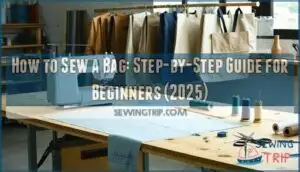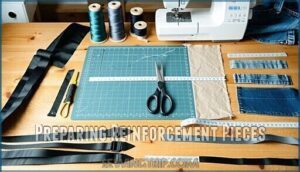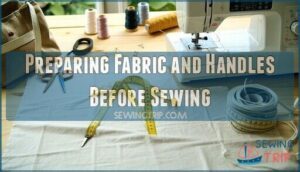This site is supported by our readers. We may earn a commission, at no cost to you, if you purchase through links.

A basic tote can take just two hours from cutting fabric to final stitch. This guide walks you through material selection, cutting techniques, and assembly steps that turn flat fabric into a functional bag.
You’ll learn which corners to reinforce, how to attach straps that won’t rip out, and finishing touches that make your project look store-bought instead of homemade.
Table Of Contents
Key Takeaways
- Beginner bag-making succeeds when you prioritize sturdy fabrics like canvas or quilters cotton, cut along the selvage edge for stability, and reinforce stress points at corners and strap attachments before decoration.
- Proper preparation—pressing fabric flat, hemming the top edge cleanly, and attaching webbing with reinforcement boxes—prevents common failures like ripped straps and sagging seams that destroy most handmade bags within weeks.
- Boxed corners transform flat fabric into structured, three-dimensional bags by stitching perpendicular lines 2-3 inches from corner points where side seams meet bottom seams.
- Over 60% of sewn bags fail at the straps within their first month, but double-stitching high-stress areas, maintaining consistent seam allowances, and finishing raw edges with zigzag stitching creates bags that withstand daily use.
Essential Materials and Tools for Sewing a Bag
You can’t sew a proper bag without the right gear in your corner. Before you fire up that machine, you need to gather your fabric, straps, tools, and a few extras that’ll make your life easier.
Here’s what belongs in your supply kit.
Choosing The Right Fabric
Fabric selection determines whether your bag holds its shape under pressure or falls apart after a few trips to the market. Choose materials that match your purpose:
- Canvas fabric – tough and structured for heavy loads
- Quilters cotton – lightweight and ideal for pattern mixing and color selection
- Muslin – budget-friendly for practice runs
Weight considerations matter. Thin fabrics need interfacing. Thick weaves stand alone. Cut along the selvage to minimize stretch and keep texture choices working in your favor. Understanding the right fabric weight options is essential for a durable bag.
Selecting Handles and Reinforcements
Your fabric’s solid. Now your bag needs to carry the weight. Straps and reinforcement fabric determine whether your tote survives heavy loads or falls apart at the seams. Here’s what works:
| Strap Materials | Best For |
|---|---|
| Nylon rope (holds 15+ kg) | Heavy-duty tote bag construction |
| Cotton rope (biodegradable) | Sustainable options and eco-friendly projects |
| Polypropylene webbing | Bag durability and custom straps |
Reinforcement types include bonded leather for structure and microfiber for flexibility. Place stiffeners at stress points—eyelets, bottom corners, and strap attachment zones. Self-adhesive versions cut production time. Glass wool reinforcement boosts tear resistance by 29% where it counts.
Match your reinforcement to your bag-making goals. Lightweight bags need less. Market totes demand more. Sewing techniques improve, but material choice builds strength from the start. For ideal results, consider using reinforcement materials to improve your bag’s durability.
Must-Have Sewing Tools for Beginners
You’ve got the materials—now you need the tools to put them together. Start with a sewing machine that manages medium-weight fabric.
Grab fabric scissors for clean cuts, a measuring tape for precision, and an iron press to flatten seams. Add a thread cutter, rotary cutter, seam ripper, and serger for professional edges.
Follow any sewing tutorial—you’ll use these basics repeatedly.
Optional Embellishments and Accessories
Once your bag is built, you can make it yours with extras that show some personality. Try fabric paint for bold designs, applique designs for texture, or sewn pockets for function. Add bag charms or ribbon ties for flair.
These sewing tips level up your bag making—just remember that sturdy webbing, straps, and reinforcement fabric come first before decoration.
How to Measure and Cut Fabric for Your Bag
Getting your fabric measured and cut right sets you up for success. You’ll want to think through your bag’s final size, cut smartly to keep things stable, and prep your pieces so they’re ready to sew.
Here’s how to nail this vital first step.
Determining Bag Size and Dimensions
Before you touch a single thread, think about what you’re actually going to carry—because the wrong size will haunt you every time you reach for this bag.
A standard tote needs fabric around 40 inches long by 23 inches wide, but don’t just follow that blindly. Measure what you’ll actually haul—groceries, books, gym gear—and add two inches to your dimension planning for seam allowances.
Your bag measurement starts with your life, not a template.
Cutting Along The Selvage for Stability
The selvage edge—that tightly woven strip running along your fabric’s length—is your secret weapon against a saggy, stretched-out disaster. Cut parallel to this selvage edge to follow the fabric grain and lock in stability.
Use a rotary cutter for clean lines and fray prevention. This cutting technique keeps your bag from warping when you load it up—because proper fabric selection and preparation means your seams stay straight, your sewing machine glides smoothly, and your finished bag actually holds its shape under pressure.
Marking and Notching Fabric Corners
Grab your fabric chalk or disappearing ink pen—corner notches are the difference between a bulky mess and crisp, professional-looking seams.
Here’s your corner cutting game plan:
- Mark your seam allowance (1/2 inch from edges) with chalk on the wrong side of your folded fabric
- Measure diagonal notches at bottom corners—small triangular cuts reduce bulk
- Cut notches precisely with sharp scissors or a rotary cutter for clean edge finishing
- Match notches on both fabric layers and reinforcement pieces for perfect alignment
- Double-check measurements before your sewing machine touches fabric—corner reinforcement depends on accuracy
These fabric notches eliminate lumpy corners and make turning your bag right side out smooth.
Preparing Reinforcement Pieces
Reinforcement fabric isn’t optional—it’s the armor that stops your bag from ripping apart when you load it with groceries, books, or whatever else you throw in there. Cut your stabilizer options to match your main fabric dimensions, keeping that 1/2 inch seam allowance. Match notches precisely so your sewing machine glides through layers without shifting.
| Reinforcement Materials | Best For | Interfacing Techniques |
|---|---|---|
| Heavy canvas webbing | Grips and stress points | Iron-on fusible for quick bonding |
| Denim or duck cloth | Bottom reinforcement patterns | Baste-stitch before final seams |
| Nylon webbing choices | Load-bearing straps | Topstitch through all layers |
Preparing Fabric and Handles Before Sewing
You’ve got your fabric cut and ready. Now it’s time to prep everything before the actual sewing begins.
These next steps will set you up for a smooth assembly process and a bag that holds up to real use.
Folding and Pressing The Fabric
Crisp folds and a hot iron turn limp fabric into something that actually wants to become a bag. Pressing techniques matter because wrinkles mess with your seam allowance and fabric grain alignment.
Here’s how to fold and press like you mean it:
- Fold your fabric in half lengthwise, matching selvage edges perfectly
- Press flat with high heat, smoothing from the center outward
- Press all cut edges to set the fabric grain
This ironing tip saves you from wrestling wonky seams later when you’re at the sewing machine.
Hemming The Bag’s Top Edge
A raw top edge screams "homemade," but a clean hem makes your bag look like you actually know what you’re doing.
Fold the top edge down half an inch, press it flat with your iron, then fold again. Pin it in place. Run your sewing machine along the edge with a quarter-inch seam allowance.
This folded hem technique gives you a professional finish that won’t unravel.
Attaching Webbing for Handles
Now that your hem is locked in, it’s time to give your bag the muscle it needs. Webbing transforms flimsy fabric into grips you can actually trust. Cut two pieces of webbing, roughly 24 inches each for grip length.
Pin them four inches from each side seam, sandwiching the raw ends under that folded hem. Stitch a reinforcement box with an X through the center—this strap attachment technique prevents ripping when you load up your bag.
Adding Interfacing or Reinforcement
Your bag’s skeleton is solid, but without proper structure, it’ll droop like wet cardboard after the first grocery run. Interfacing types like fusible or sew-in stabilizer options add the backbone your fabric needs. Iron interfacing onto the wrong sides of the main panels before assembly—this structural support locks in bag stability without adding bulk.
Reinforcement materials worth your time:
- Fusible fleece – soft padding that bonds with heat
- Pellon or Décor Bond – crisp interfacing for clean lines
- Canvas doubling – layer extra fabric at stress points
- Denim strips – reinforce seam allowance areas prone to tearing
These sewing techniques and tips transform basic fabric crafting into bag-making tips and tricks that last. Apply reinforcement before your first stitch for sewing for beginners success.
Step-by-Step Bag Assembly Instructions
Now that you’ve prepped everything, it’s time to put your bag together. This is where your project actually starts looking like a real bag.
We’ll walk through pinning, sewing, and finishing each part so you end up with something sturdy and professional.
Pinning and Sewing Side Seams
Once your side seams are lined up and pinned, you’re ready to sew the bag into its basic shape. Set your sewing machine to a straight stitch and maintain a consistent half-inch seam allowance. Backstitch at the start and end for corner reinforcement and bag stability.
Keep your fabric tension steady as you guide the material through—this sewing accuracy separates beginner mistakes from pro results.
Sewing The Bottom Seam Securely
With the sides secured, the bottom seam becomes the foundation that holds everything together under weight. This is where secure stitching and proper seam allowance matter most for fabric stability. Use your sewing machine to stitch straight across, backstitching at both ends for seam reinforcement. Keep your edge finishing clean—beginners, if mistakes happen, a seam ripper fixes them fast.
Three power moves for bottom seam confidence:
- Double-stitch high-stress areas where straps attach—weight distribution depends on this.
- Check your thread tension before committing; puckered seams weaken the entire bag.
- Press seams open immediately for professional bottom hemming and a flat, stable base.
Master this step and your sewing projects gain the durability that separates handmade from homemade.
Creating Boxed Corners for Shape
Boxed corners transform a flat fabric pouch into a structured, professional-looking carryall. Pull one bottom corner flat so the side seam aligns with the bottom seam, creating a triangle. Measure 2-3 inches from the point (larger bags need wider measurements), mark a straight line perpendicular to the seam, then stitch across.
This corner stitching technique—essential for bag shaping—gives your handmade bag-making project that store-bought depth. Trim excess fabric, leaving 1/4 inch, and repeat on the opposite corner for balanced boxed edges.
Finishing Seams to Prevent Fraying
Unfinished seams fray fast—especially on bags that’ll haul groceries, books, or whatever else you throw their way. Run a zigzag stitch or overlock stitching along raw edges with your sewing machine to lock fibers in place. No serger? A simple zigzag works wonders for fray prevention.
For extra fabric stabilizer strength, try pinking shears or fold edges under for a quick hem—beginner sewing doesn’t require fancy edge binding to look sharp.
Finishing Touches and Customization Ideas
You’ve sewn the bag together—now it’s time to make it yours.
This is where your bag goes from functional to finished. Let’s cover the final steps and ways to add personality to your creation.
Turning The Bag Right Side Out
Flip that inside-out mess into a proper bag and watch your project transform from a pile of seams into something you’d actually carry. Reach inside, grab the bottom corners, and pull everything through the opening. Smooth out those seams with your fingers and press flat with your iron.
Here are your bag turning tips for a clean finish:
- Push out corners completely using a chopstick or point turner—don’t leave them bunched up inside
- Press all seams flat while fabric’s still warm for professional-looking edges
- Trim any loose threads before turning to prevent them from poking through
- Check that your tote bag opening sits evenly on both sides after flipping
- Give stubborn fabric a firm tug at the seams to eliminate puckering and achieve proper corner shaping
Reinforcing Seams and Handles
Those stitches holding your bag together won’t survive a single grocery haul unless you lock them down with serious reinforcement. Run a second pass over stress points where straps meet the hem—that’s where bags rip first. Use your sewing machine’s reverse stitch at strap attachment points and along side seams.
Test durability by loading your finished bag with heavy items before declaring victory. Smart webbing selection and proper seam reinforcement turn flimsy bag-making attempts into bulletproof carriers.
Adding Drawstrings or Closures
A drawstring transforms your open tote into a cinched fortress that keeps contents from spilling when you’re running for the bus. Punch evenly spaced holes near the top hem, thread your cord through using a safety pin, and cinch tight.
For closure options beyond drawstrings, consider magnetic snaps or velcro strips—both work great for beginner sewing without requiring zipper installation skills.
Your DIY sewing project just leveled up.
Decorating With Tags, Appliqué, or Fabric Paint
Personalization is your rebellion against mass-produced sameness. DIY tag crafts take under 10 minutes and cost around $5—cut cardstock, add acetate windows, and reinforce with duct tape for Fabric Bag durability.
Appliqué Art layers fabric shapes using Wonder Under adhesive, while Fabric Painting transforms plain surfaces with acrylics.
Custom Embellishments like beads or embroidery enhance Handmade Bag Making into wearable art. These DIY Crafting Projects require no Sewing Machine Usage—just bold vision and steady hands for Paint Effects that scream originality.
Frequently Asked Questions (FAQs)
How can I create a flat bottom for the tote bag?
Creating a flat bottom transforms your tote from floppy to functional. Pinch each bottom corner, align the side seam with the bottom seam, and sew straight across. This box corner method gives your bag stability and structure.
What are some essential tools and notions for sewing?
You’ll need a sewing machine, fabric scissors, measuring tape, and thread. Don’t forget pins, a seam ripper for mistakes, and needles that match your fabric weight. Quality tools make every project easier.
How can I make my sewing bag more travel-friendly?
Ironically, the bag you just sewed needs its own packing strategy. Add zipper pockets for thread spools and scissors. Reinforce grips with extra webbing to bear weight. Include luggage straps on the back so it slides onto rolling bags.
Design a foldable tote bag that collapses flat when empty—ideal travel accessories for fabric bag enthusiasts.
How do I wash a handmade fabric bag?
Check your tote bag’s fabric care first. Hand washing in cold water works best for most fabric bags, including canvas and muslin.
Spot clean stains gently, then air dry flat to maintain shape.
Can I sew a bag without a machine?
Yes, hand sewing a bag is totally doable. You’ll need a sewing kit with strong thread, a sharp needle, and patience. DIY stitches like backstitch work well.
For beginners, fabric glue or no-sew bags offer easier alternatives to sewing machine projects.
Whats the best way to add pockets inside?
Sew your pocket piece first, then pin it to the bag’s interior before assembling side seams. Position pockets where you’ll actually reach—not too high or low.
Consider zipper pockets for valuables or simple patch pockets for quick access.
How do I fix mistakes in bag stitching?
Don’t let a crooked seam throw you off track. Stitch removal is your best friend—carefully use a seam ripper to pull out error correction threads, then adjust thread tension and re-sew.
For weak seam repair, reinforce with a second pass.
Torn fabric? Fabric patching saves the day.
Can I make a bag waterproof after sewing?
Waterproof your finished bag with spray-on fabric sealant or wax-based treatments. Apply waterproof coatings evenly, or use laminated fabrics as linings.
Seal seams with tape and add waterproof zippers for complete protection.
Conclusion
Over 60% of sewn bags fail at the straps within their first month—but yours won’t if you’ve followed this guide. Learning how to sew a bag correctly means reinforcing stress points and choosing fabric that withstands daily use.
You’ve cut, stitched, and assembled something functional with your own hands. That’s not just a project completed—it’s proof you can build anything you need instead of waiting for someone else to make it for you.













